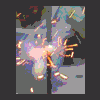Can Sodium Bicarbonate be substituted for sodium oxylate?
#1

Posted 22 January 2009 - 01:28 PM
My son's favorite color is yellow, and I'm hoping to make some yellow stuff (lances, stars...). Many of the formulas require sodium oxylate (sp?) which I don't have. One formula stated I could use sodium bicarbonate instead. Is this universally true, or does this sound like a special case? I can post more details if needed.
Thanks for any advice.
(Lev 2:9)
--seems to me that if God likes the odor of burnt cereal, He's just gotta love gunpowder...
#2

Posted 22 January 2009 - 01:45 PM
Barium nitrate green comps, with a small addition of cryolite or even sodium benzoate will turn it from green to light, lemony yellow. With such a mix, a bit of barium carbonate also serves well as the “antacid”. This is from some old notes, I do not know who to credit it to.
EDIT- The addition of sodium bicarb to a barium nitrate-based green might do the same thing as cryolite, above- sodium is a strong emitter. Some testing would be needed...
Edited by spanner, 22 January 2009 - 01:52 PM.
#3

Posted 22 January 2009 - 02:57 PM
Spanner mentions cryolite and this is good for yellows, as it's not hygroscopic, cheap and easy to get from ceramic (pottery) suppliers.
 thegreenman
thegreenman
#4

Posted 22 January 2009 - 04:21 PM
As spanner mentioned, Sodium is a strong emitter. You can even get away with using table salt to make a passable yellow in some comps...
It might be worth mentioning that a really good lemon yellow can be quite hard to achieve. Traffic light amber is easy. What kind of yellow are you looking for?
#5

Posted 22 January 2009 - 06:13 PM
#6

Posted 22 January 2009 - 06:48 PM
Keep mannequins and watermelons away from fireworks..they always get hurt..
#7

Posted 24 January 2009 - 02:19 PM
Barium nitrate 12.5
Potassium perchlorate 50
Sodium oxalate 25
Shellac 12.5
--from A. Hardt "Pyrotechnics"
come to think of it, I don't have shellac as a powder, just as a solution (in acetone, I think). Anyhow, could I substitue sodium bicarb or cryolite, or do I just need to wait til I can get some sodium oxalate?
Perfect for me would be any formulas for yellow stars or Gerbs without sodium oxalate, or chlorates (I'm still afraid of chlorates). Ammonium perchlorate is also a challenge for me because of the priming issue.
(Lev 2:9)
--seems to me that if God likes the odor of burnt cereal, He's just gotta love gunpowder...
#8

Posted 24 January 2009 - 08:02 PM
Bicarb would work OK in that, but I think you'd need rather less off it, otherwise it'll retard the burning too much. The main no-no with bicarb would be mixes with aluminium in them (especially uncoated) as it's potentially a bit alkaline in solution. Lancaster gives a simple yellow lance mix:Thanks for all the info! My first goal was a yellow lance:
Barium nitrate 12.5
Potassium perchlorate 50
Sodium oxalate 25
Shellac 12.5
--from A. Hardt "Pyrotechnics"
come to think of it, I don't have shellac as a powder, just as a solution (in acetone, I think). Anyhow, could I substitue sodium bicarb or cryolite, or do I just need to wait til I can get some sodium oxalate?
Perfect for me would be any formulas for yellow stars or Gerbs without sodium oxalate, or chlorates (I'm still afraid of chlorates). Ammonium perchlorate is also a challenge for me because of the priming issue.
KClO4 75
Cryolite 10
Red gum 15
which should be easy. If you don't have red gum, other fuels would likely do OK.
Edited by pyrotrev, 24 January 2009 - 08:43 PM.
1 user(s) are reading this topic
0 members, 1 guests, 0 anonymous users














